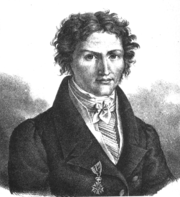
Johann Baptist von Spix
Encyclopedia

Germany
Germany , officially the Federal Republic of Germany , is a federal parliamentary republic in Europe. The country consists of 16 states while the capital and largest city is Berlin. Germany covers an area of 357,021 km2 and has a largely temperate seasonal climate...
naturalist
Natural history
Natural history is the scientific research of plants or animals, leaning more towards observational rather than experimental methods of study, and encompasses more research published in magazines than in academic journals. Grouped among the natural sciences, natural history is the systematic study...
.
Spix was born in Höchstadt
Höchstadt
-Geography:Höchstadt is situated on the river Aisch, 18 km northwest of Erlangen and 22 km south of Bamberg. Originally it was the capital of the Höchstadt district, but then it became part of the new Erlangen-Höchstadt district.-Division of the town:...
, Middle Franconia
Middle Franconia
Middle Franconia is one of the three administrative regions of Franconia in Bavaria, Germany. It is in the west of Bavaria and adjoins the state of Baden-Württemberg...
, as the seventh of eleven children. His boyhood home is the site of the Spix Museum http://www.qype.co.uk/place/801481, opened to the public in 2004. After his first fundamental publication, a book about the history of zoological classification, published in 1810, he was appointed as a member of the Bavarian Academy of Sciences. In 1817 he travelled to Brazil
Brazil
Brazil , officially the Federative Republic of Brazil , is the largest country in South America. It is the world's fifth largest country, both by geographical area and by population with over 192 million people...
with Carl Friedrich Philipp von Martius
Carl Friedrich Philipp von Martius
Carl Friedrich Philipp von Martius was a German botanist and explorer.Martius was born at Erlangen, where he graduated M.D. in 1814, publishing as his thesis a critical catalogue of plants in the botanic garden of the university...
, returning in 1820 with specimens of 6,500 plants, 2,700 insects, 85 mammals, 350 birds, 150 amphibians and 116 fish. These formed the basis of the collection of the Natural History Museum
Zoologische Staatssammlung München
Zoologische Staatssammlung München or ZSM or The Bavarian State Collection of Zoology is a major German research institution for zoological systematics. With over 20 million zoological specimens it is one of the largest natural history collections in the world. The sections are Entomology,...
in Munich
Munich
Munich The city's motto is "" . Before 2006, it was "Weltstadt mit Herz" . Its native name, , is derived from the Old High German Munichen, meaning "by the monks' place". The city's name derives from the monks of the Benedictine order who founded the city; hence the monk depicted on the city's coat...
, of which he was the first conservator (now about equal to director). Among his discoveries was Spix's Macaw
Spix's Macaw
Spix's Macaw is the only member of the parrot genus Cyanopsitta. They are critically endangered, possibly extinct in the wild The species is conserved through several breeding programs. It was found in Brazil, in parts of the Brazilian state of Bahia...
, which is named after him. The is also the museum's sponsoring award Ritter-von-Spix-Medal
Ritter-von-Spix-Medal
The Zoologische Staatssammlung München awards the Ritter-von-Spix-Medal to distinguished donors and benefactors of outstanding zoological collections...
wearing his name.
Spix died in Munich.
Works
- Geschichte und Beurtheilung aller Systeme in der Zoologie nach ihrer Entwicklungsfolge von Aristoteles bis auf die gegenwärtige Zeit. 1811 - Nürnberg, Schrag'sche Buchhandlung I-XIV; 710pp.
In addition to the 4-volume narrative of the expedition, Reise in Brasilien in den Jahren 1817 bis 1820 (Munich,1823-1831), the publications arising directly from the Spix-Martius collections include:
- Simiarum et Vespertilionum Brasiliensium Species Novae [monkeys and bats], 1823, by Spix. From Smithsonian Institution Libraries
- Serpentum Brasiliensium Species Novae [snakes], 1824, by J.G. Wagler, from Spix's notes
- Animalia Nova sive Species Novae Testudinum et Ranarum [turtles and frogs], 1824, by Spix
- Animalia Nova sive Species Novae Lacertarum [lizards], 1825, by Spix
- Avium Species Novae [birds], 1824-1825, by Spix
- Testacea Fluviatilia... [freshwater mollusks], 1827, by A.J. Wagner
- Selecta Genera et Species Piscium [fish], 1829[-1831], by Louis Agassiz
- Delectus Animalium Articulatorum [insects], 1830, by Maximilian PertyMaximilian PertyJosef Anton Maximilian Perty was a German naturalist and entomologist. He was a professor of natural history at the University of Bern.-Works:...
- Novae Genera et Species Plantarum [plants], 1823-1832, by Martius
- Plantarum Cryptogamicarum [cryptogams], 1828, by Martius
External links
- Smithsonian Library
- works by Johann Baptist von Spix at Internet ArchiveInternet ArchiveThe Internet Archive is a non-profit digital library with the stated mission of "universal access to all knowledge". It offers permanent storage and access to collections of digitized materials, including websites, music, moving images, and nearly 3 million public domain books. The Internet Archive...

